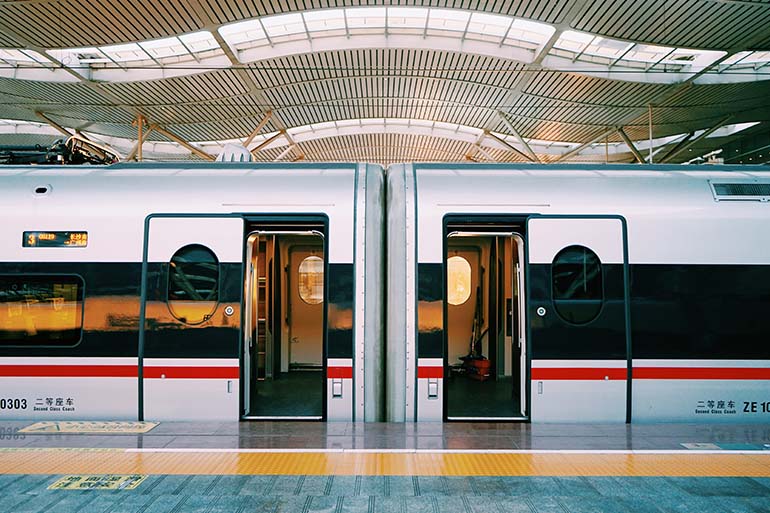June 7, 2024
October 3, 2023
Much has improved in Spain over the years, and one of the most noticeable changes is the country's public transportation system. Whether it's by train, bus or car, Spain's transportation options offer something to every tourist, traveler, and resident. If you choose to move around by car, you'll be able to enjoy the freedom and flexibility of stopping anywhere along the 'camino' that catches your attention, but make sure you know what your car insurance requirements might be.
Keep reading to discover the top 3 Spain transportation options: car, train and bus.

Spain Transportation Option #1: Car
General Information on Driving in Spain
Spain has an incredible highway system and all you need is an EU driver’s license to drive around. If you are a non-EU citizen, we recommend you get an International Driver's License or start the process to convert your foreign license to a Spanish license.
Remember, the Spanish drive on the right and the speed limit on most highways (autopistas) is 120kph. On autovías, (second grade roads) it's 90kph and in most cities and towns it's 50kph or below. Keep in mind that speed limits are enforced and the police have the power to fine you on the spot.
Toll roads (designated by an “AP”, “R” or the word Peaje, meaning toll) are an excellent way to avoid traffic and you can pay with cash or a credit card. For gas fill-up or a quick break from driving, head to a gasolinera (gas station) like Repsol or Cepsa.
Renting or Owning a Car in Spain
There are hundreds of car rental services including worldwide companies such as Avis or Hertz, and local Spanish companies like Pepecar. To rent a car in Spain you must be 21 or older, have a proper driver's license and be prepared to leave cash deposit. Also, make sure you have insurance in case of an accident or road assistance. Another excellent option is blablacar, which connects people who need to travel with drivers who have empty seats. Plus it's a wonderful way to meet new people and practice your Spanish.
If you plan on owning a car in Spain, apart from vehicle registration, you'll need car insurance, two hazard triangles, reflective jackets and a first aid kit. As a Caser Expat Insurance policy holder, remember that the service comes with 24-hour a day personalized assistance in English and a courtesy vehicle in case of a mayor breakdown. See more on Caser car insurance below.
Car Insurance in Spain
In Spain, it is mandatory to have at least third-party car insurance coverage. Third party insurance means that, in the event of an accident, your insurance will cover the other person involved, although neither you nor your car will be covered. So what is our basic coverage and what are the other options? Caser offers 5 different car insurance coverages for expats living in Spain. Below, discover what each one entails:
- Basic Third Party Insurance: This is the basic insurance required to drive in Spain, covering Compulsory Civil Liability, Voluntary Civil Liability, Caser Autohelp, Legal Defence, and more.
- Third Party Car Insurance with Windscreen Cover: This adds onto the basic coverage and includes windscreen cover, providing you coverage for 100% of the cost of repairing and replacing the windowpanes in your car.
- Extended Third Party Car Insurance: Our most extensive third party car insurance plan, with coverage for theft, fire, etc. It's a slightly more economic option than the full coverage plan.
- Comprehensive Full Coverage Insurance: For new or cars less than 5 years old, this is the best full coverage auto insurance we offer. It includes all Caser coverages to keep your car in impeccable condition, at a reduced price thanks to the excess.
- Coche x Coche Car Replacement Insurance: This is a special insurance that provides you with another car under ownership in the event of a total loss.
Parking Rules in Spain
If you plan on driving around Spain, keep in mind that there are metered parking zones in big cities and old-town areas. Saturday afternoons, weekdays between 8pm and 8am, and Sundays are free. Otherwise, double-check before you park as there are green and blue bays, which mean you'll have to pay to park. Other options are leaving your car in a secured parking lot or checking with your hotel to see whether it has parking facilities.
Spain Transportation Option #2: Train
General Information on Trains in Spain
The rail network reaches all the provincial capitals and main towns along the inter-city lines. Just keep in mind that train stations in smaller towns are usually located a few kilometers away. Most Spanish trains are operated by state-owned company RENFE, but recently there are new operators in the country, including OUIGO and iryo. Many of the trains are modern, high speed trains, and all trains operating in Spain tend to be comfortable, fast and efficient.
Advance tickets can be purchased at the stations between sixty days and five minutes before departure, but we recommend doing it online, as there can be long lines in the stations. Make sure you check for deals on train company websites, sometimes you can get huge discounts on full fares!
Some words to remember when looking into train transportation in Spain are billetes (tickets), ida y vuelta (round trip) or solo ida (one-way). If you are over 60 or under 26, disabled or are traveling with children between 4 and 11 years old, you can enjoy discounted fares of up to 20 and 40%.
Local and Long-Distance Trains
The local commuter trains are called trenes de Cercanías and take you in and around major cities. Media distancia are regional trains and larga distancia are long distance trains, which are divided into Avant, Alaris and Ave, the country's high-speed trains. The difference is price, speed and number of stops.
Taking Spain's legendary AVE, which stands for Alta Velocidad Española, (Spanish High Speed) is the best option if you want to save time, enjoy the plush seats, movies, and the bar. The initials are a play on the word ave, meaning, "bird". Did you know that it's the longest HSR network in Europe covering 3,100 km and is the second in the world, after China?

Spain Transportation Option #3: Bus
Buses are a wonderful way to travel throughout rural parts of the country and between cities. It might be slower, but it's also more affordable and ideal for short distances. A bus from Madrid to Santander, for example, will cost you around €30 and takes about 6 hours. There are many bus companies who operate within the country. One of the most prominent companies is ALSA and it's well known for its reliability, services and efficiency.
Key words to remember are laborables (workdays, including Saturdays), diario (daily) and domingos and festivos (Sundays and Public Holidays.)
Any option you Spain transportation option you choose is sure to get you where you need to go! While trains and buses are great, you may already be thinking about buying a car or motorbike in Spain. Do you know the annual costs it involves? Our free guide will tell you:
|
If you are searching for car insurance in Spain, Caser Expat Insurance has the right policy for you! |
.png?width=344&height=67&name=logo_caser%20(2).png)








Let Us Know What You Thought about this Post.
Put your Comment Below.